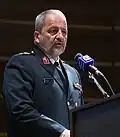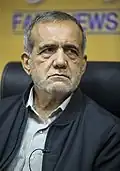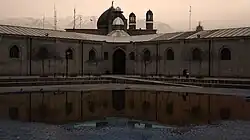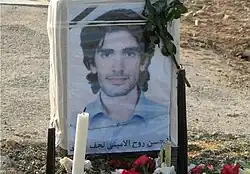Professionalism/The Mysterious Death of Dr. Ramin Pourandarjani
Timeline of the Case
Dr. Ramin Pourandarjani began working at the Kahrizak detention center in the spring of 2009, shortly after completing a one-month assignment in Sistan and Baluchestan province as part of his mandatory military service. Upon returning to Tehran, he was assigned to Kahrizak, where he served as the facility's physician. At Kahrizak, Dr. Pourandarjani was responsible for providing medical care to detainees, most of whom had been arrested during the post-election protests in June 2009. He conducted weekly visits to the detention center, treating prisoners who had suffered injuries, including those resulting from torture. His tenure at Kahrizak coincided with a period of intense scrutiny over the treatment of detainees, particularly following the death of Mohsen Ruholamini, a prominent case that drew significant public attention.
Mohsen Rouholamini was a graduate student in the computer engineering department at the University of Tehran, and the son of a prominent Iranian conservative and presidential adviser. Rouhalamini was arrested on July 9, 2009 in connection with the election protests, and was taken to the Kahrizak detention center due to lack of space for inmates in Evin Prison, where most protestors were held. The underground prison provided no access to fresh air or toilet facilities for prisoners, and officials claimed only the most dangerous offenders involved in the election protests would be housed there. However, the government later admitted the 50 prisoner capacity facility was packed with more than 140 prisoners, most of whom were low priority suspects. Less than two weeks later he was taken to a hospital where he died, surrounded by his family, from cardiac arrest and internal bleeding, with accounts claiming "his face had been smashed." Officials claimed he died from meningitis, however Dr. Pourandarjani’s official report, released to the press on August 31, 2009[1], described his cause of death as "physical stress, the effects of being held in bad conditions, multiple blows and severe injuries to the body."
Among four confirmed deaths of those detained at Kahrizak, Rouholamini’s father's influence drew attention to the issue, causing even conservative Iranian lawmakers and politicians to express public outrage. In August, a former presidential candidate and cleric publicly accused Iranian police of having tortured and raped detainees in Kahrizak prison and demanded an investigation, prompting a swift police raid of his office, in which names, addresses, and testimonies of witnesses were confiscated. Supreme Leader Ali Khamenei ordered an investigation into the death of Rouholamini, and soon afterwards ordered the closure of Kahrizak. In October, the deputy chief of the national police announced that although ten persons were under investigation for misconduct at the Kahrizak facility, the issue was minor and not widespread. Authorities at Kahrizak detention center attempted to cover up the cause of their deaths by pressuring Dr. Ramin Pourandarjani to change the registration of the victim's cause of death, but Pourandarjani repeatedly declined the request.
Sometime in late summer or early fall of 2009, Pourandarjani was called to testify before the parliamentary Special Majles Committee investigating misconduct at the Kahrizak jail, and asked to give a review of his report[2]. In the days following his testimony, Pourandarjani was arrested and interrogated several times by the police force's investigative unit, the martial court, and the Physician General's regulatory council on charges of “failure to perform medical duties” within the prison. The Interrogation Department prevented Ramin from fetching documents in Kahrizak detention center that showed he had sent the patients to the hospital and had even prescribed more medicine for them, documents that would've proved his innocence. After some time, he was released on bail, and warned to say nothing further about what he had seen at Kahrizak, and threatened with further imprisonment and seizure of his medical license.
A later plaintiff in the Kahrizak case testified that Pourandarjani told them the conditions he witnessed in the detention center were so distressing that he was constantly distraught, and was himself suffering from what he had witnessed. Pourandarjani claimed that whenever the police chief and his team came to Kahrizak, they would prevent him from even taking the detainees’ pulses. Pourandarjani was continually threatened by officials from Kahrizak detention center and the office manager of the commander of Tehran Law-Enforcement Force, warning him that he would be "dealt with" if he ever mentioned names of any of the authorities who came to Kahrizak to administer torture[3]. Pourandarjani not only knew these names, but allegedly had extensive documentation, and shared with the plaintiff stories of white sacks in Kahrizak in which they put live prisoners. The plaintiff claimed that Pourandarjani was scheduled to meet with members of a Majles committee, in which the names of those who had tortured the Kahrizak detainees would have been mentioned.
Soon after his release on bail, on the morning of November 10, 2009, Dr. Ramin Pourandarjani was found dead in the FATEB Clinic’s Psychology Room where he now worked as a duty physician, continuing his 19-month stint of obligatory military service as a general practitioner. Pourandarjani routinely slept in the clinic, housed within the Tehran police medical center, as his residence was too far outside Tehran to commute daily[3]. He was found lying flat on a medical bed with vomit around his mouth in a supine position with his right leg curled up, and signs of bruising and blood spots were visible on his neck. On the dining table next to him there was a half-eaten meal and his personal medical supplies. The coroner's report listed his official cause of death a “heart attack". His body was buried in his hometown of Tabriz on November 18, 2009, however authorities barred his parents from ever seeing his body or conducting an autopsy to discover the cause of their son’s death.
Background Context: Political Turmoil
Pourandarjani’s patients imprisoned at the Kahrizak detention center were members of the Iranian Green Movement, a symbol of unity and hope for those asking for annulment of the 2009 Iranian presidential election. After the election on June 12, incumbent president Mahmoud Ahmadinejad declared victory only 2 hours after the closing of polls, causing massive protests to break out across the country in support of the progressive opposition candidates. In the following hours, all three opposition candidates claimed the votes were manipulated and filed appeals, officially launching an investigation on claims of electoral fraud. External experts have conducted investigations and concluded that there is "strong support for a diagnosis that the 2009 election was affected by significant fraud.”
In the following days, millions of citizens took to the streets to protest, with violence breaking out in multiple cities; police and military suppressed protesters with beatings, pepper spray, weapons, and guns, killing many in the process. On June 14, paramilitary groups raided Tehran University to suppress protesting students, arresting over 200 people and severely injuring many. In house raids across Tehran, government officials arrested 170 leaders of the protesting opposition, many being prominent reformist politicians, including a former vice-president, a former presidential advisor, a prominent human rights lawyer who had been demanding a recount of all votes, and a former foreign minister and secretary-general of one of Iran’s major political parties. On that same day, over 100 students and 15 journalists were arrested after security forces fired tear gas at protesters at Shiraz University. In the days following, the Iranian government heavily censored media, restricting newspaper publishing, closing the offices of major state television broadcasts, raiding the Tehran NBC News offices, blocking BBC from broadcasting in the country, and arresting foreign television reporters.
On June 19, Iran’s clerical Supreme Leader spoke during religious services, calling the election results legitimate and “a divine assessment” and declaring that protesting would no longer be tolerated by the government. The opposition did not accept this, and that protests that continued in the following days were met with extreme violence. One young woman, Neda Agha-Soltan, was shot and killed by police on camera, causing graphic videos of the killing to go viral, and the movement to adopt her as a martyr. On June 22, the newly appointed commander of the Revolutionary Guards in Tehran was arrested for refusing to carry federal orders to use violent force against demonstrators. On June 29, the Guardian Council officially certified the results of the election, setting off another wave of protests, in spite of the strict ban. The Iranian intelligence chief attempted to frame this unrest as incited by western and "Zionist" forces attempting to destroy Iran; many protestors were arrested and charged with plotting with foreign media and terrorist organizations, despite absent evidence.
For the next few months protests continued through the boycotting of goods advertised on state-controlled television, sabotage of state-run television evening news broadcasts, identification and exposure of violent suppressors, and adoption of the chant 'Death to the dictator!' in brief street demonstrations. On August 5, Mahmoud Ahmadinejad was officially inaugurated for his second term as President of Iran, as thousands of protesters outside chanted "death to the dictator". That day the Association of Iranian Journalists was forcibly closed and raided by government security forces, and foreign journalists from Britain, Italy, America, and Germany were beaten and robbed of their material.
Aftermath of the Protests
Iranian authorities admitted that over 4,000 people had been arrested and detained during the June protests, but claimed only around 300 were being held on charges long term. The government issued very little official information on those killed during the protests, admitting to around 30 fatalities, but news organizations suggest the toll could be closer to 150 killed. Hospitals were prohibited from registering the dead bodies or injured people, with nurses reporting “the government removed the dead bodies on the back of trucks, before we were even able to get their names or other information." The families of those killed were forced to sign paperwork alleviating the government of blame before claiming their bodies, and required to pay hefty fees to refund the bullets used to kill them; many were barred from holding memorial services.
Estimates suggest that over 500 prisoners were held in prisons for extended periods of time, subjected to horrific torture and abuse. Opposition leaders claimed that many prisoners had been severely tortured and raped in prison, and while Iran's parliament speaker denied such allegations, Iran's police chief general acknowledged them. Over 100 detainees were put on trial for their involvement in the protests, including political leaders, activists, journalists, lawyers, and foreign emissaries, with their cases criticised by human rights campaigners. In the months following the protests, Iranian state media transmitted forced confessions by protestors claiming they were instructed by foreign media agencies; heavy facial bruising from torture required their faces be obscured in the broadcasts. Several of those detained died while in prison, with their bodies posthumously exhibiting signs of torture, including broken bones, finger nails torn off, and rape; authorities cited causation as "pre-existing conditions". Most confirmed and publicized deaths in custody occurred at the Kahrizak detention center, however evidence suggests that deaths may have occurred in other facilities though never officially acknowledged.
About Dr. Ramin Pourandarjani
Dr. Pourandarjani was recognized early on for his intellect and dedication as a “gifted child and honor student at the Medical School of Tabriz.”[3]. Admitted to a school for gifted students at age 11, he later graduated with distinction from the University of Tabriz's medical school in 2008. In his graduation speech, he emphasized the sanctity of the medical profession, stating: “We are heirs to great names; luminaries such as Galen, Hippocrates, Avicenna and the wise Al-Juzjani. We have been left to carry the legacy of an incredibly remarkable holy spirit from those eras, transmitted to us in the form of a white gown. We are here to say that we will continue this path with passion.”
Assigned to Kahrizak as part of his mandatory military service, Dr. Pourandarjani was responsible for treating detainees, many of whom bore signs of severe torture. He faced immense pressure from authorities to falsify medical reports, particularly concerning the death of Mohsen Ruholamini, a detainee who died from injuries sustained during torture. Despite threats to his career and personal safety, including potential imprisonment and revocation of his medical license, he refused to alter the cause of death on official documents.
Due to systemic repressions, the reporting of such torture by himself earlier was nearly impossible. Iran's security and judicial systems were (and are) heavily controlled by the same forces responsible for the torture.[4] This meant that there was no safe channel to report such human rights abuses. Dr. Pourandarjani was also under military service orders at the time. Thus, as a conscripted military doctor, he couldn’t speak freely without risking immediate punishment — possibly prison or worse — for insubordination or "revealing state secrets."
Summoned before a parliamentary committee investigating abuses at Kahrizak, Dr. Pourandarjani provided a candid account of the conditions and treatment of detainees. He testified: “They brought Mohsen Ruholamini to me two days before his death after he had been subjected to intense physical torture and was in a dreadful condition. His physical condition was very critical. Despite my very limited medical facilities, I did my best to save him. It was then that I received threats from Kahrizak authorities who warned me that if I said anything about the cause of the Kahrizak victims’ injuries, they would put an end to my life.”[5]
Following his testimony, Dr. Pourandarjani was detained for a week and subjected to interrogations. He was released on bail but continued to receive threats warning him against disclosing information about the abuses he had witnessed. Friends reported that he expressed fear for his life, indicating that the intimidation began before his court appearance and persisted thereafter. Overall, his efforts to combat the injustices taking place were limited to his refusal to falsify the autopsy of Mohsen Ruholamini, his truthful testimony to the parliamentary inquiry, and telling his family and friends that he was fearful for his life. His commitment to medical ethics and human rights placed him in a perilous position, ultimately leading to his untimely death under suspicious circumstances.
Iran's Officials and Media Contradictions and Long Prison History
-
 Gen. Esmail Ahmadi-Moghaddam (Iran’s police chief)
Gen. Esmail Ahmadi-Moghaddam (Iran’s police chief) -
 Abbas Jafari-Dolatabadi (Tehran’s Prosecutor General)
Abbas Jafari-Dolatabadi (Tehran’s Prosecutor General) -
 Dr. Masoud Pezeshkian (MP and former health minister)
Dr. Masoud Pezeshkian (MP and former health minister) -
.jpg) Gen. Ahmad-Reza Radan
Gen. Ahmad-Reza Radan
The Official Accounts of the Iranian Government and Media
On 18 Nov 2009, Police Chief Gen. Esmail Ahmadi‑Moghaddam told state media that Dr. Ramin Pourandarjani’s death “was the result of suicide.” He claimed the young physician had “lost his spirit” after being summoned in the Kahrizak‑abuse case and had left a note fearing a five‑year jail term, concluding that “he committed suicide after he was summoned to the court”[6].
Tehran Prosecutor Abbas Jafari‑Dolatabadi issued several—and contradictory—statements. In late November his office insisted a “preliminary autopsy revealed he did not die of poisoning,” apparently to quash widespread rumors[7]. Yet on 1 Dec 2009 he reversed course: forensic tests now showed the doctor had ingested a lethal propranolol overdose hidden in a delivered salad, and tablets were allegedly found beside the meal. Dolatabadi said investigators still had to decide whether the overdose was self‑administered or foul play[8].
Inside parliament, opinions diverged. Former health minister Dr. Masoud Pezeshkian dismissed the suicide theory, noting no coroner had certified such a finding and calling the claim “just a rumor.” Conversely, hard‑line MP Vali Esmaili echoed the official suicide line while stressing that the death “had no connection with the post‑election events,” a rhetorical move meant to decouple Pourandarjani from the detainee‑abuse scandal.
State‑run outlets—IRNA, ILNA, the conservative daily Kayhan—faithfully tracked each narrative shift: heart attack, poisoning, suicide, finally overdose. The oscillation itself became news, undercutting the credibility of every new claim.

Why Pourandarjani’s Death Matters
Iran’s modern history is entwined with notorious political prisons. Evin and Qasr (pre‑1979) and Rajaei Shahr (post‑revolution) set the template for systematic abuse; torture in solitary cells, forced confessions, and extrajudicial killings never disappeared. Kahrizak, built in 2001 and repurposed in 2007 by Police Chief Gen. Ahmad‑Reza Radan, became the newest link in that chain[9].

After the disputed June 2009 election, more than 140 protesters were crammed into Kahrizak’s windowless underground block—built for only 50—enduring beatings by guards and reported foreign agents. Among the dead was Mohsen Ruholamini, whose broken jaw and infected wounds shocked even conservatives. Dr. Pourandarjani examined him, wrote that he died from “multiple blows and severe injuries,” and refused to falsify the report to “meningitis”[10] By testifying to parliament he confronted the very machinery that sustains Iran’s prison‑torture legacy—and became its next victim. His suspicious death, followed by four contradictory state narratives, turned him into a symbol of how far the regime will go to silence professionals who expose abuse.
Professional Ethics Discussion

Pourandarjani’s fate epitomizes the clash between medical ethics and state power. The World Medical Association holds that physicians must place patient welfare above political coercion. Yet at Kahrizak, truthful certification of torture deaths was treated as treason[11].
Confronted with orders to falsify records, Pourandarjani chose integrity: he documented injuries, testified, and warned that detainees were dying from abuse. The reward was arrest, threats of license revocation, and ultimately death. With no whistle‑blower protection and investigations monopolized by the very security forces implicated, honesty became lethal. Officials then smeared him as depressed or negligent to discredit his testimony.
Professional ethics cannot survive where truth‑telling is criminalized. Whether physician, journalist, or engineer, ethical codes require institutional shields. Absent them, each act of honesty—like Pourandarjani’s—stands isolated, heroic, and tragically perilous.
Sources
- ↑ "Iranian Doctor Confirms Prison Abuse Death - CBS News". www.cbsnews.com. 2009-09-01. Retrieved 2025-05-06.
- ↑ Erdbrink, Thomas (2009-11-18). "Iran's judiciary said to be examining death of prison doctor" (in en-US). ISSN 0190-8286. https://www.washingtonpost.com/wp-dyn/content/article/2009/11/17/AR2009111701664.html.
- ↑ a b c "Ramin Purandarjani: One Person's Story". Abdorrahman Boroumand Center. Retrieved 2025-05-05.
- ↑ "I was tortured by Iran's Revolutionary Guard - I have no fingerprints left". The Sun. 2024-12-22. Retrieved 2025-05-05.
- ↑ "The Mysterious Death of a Kahrizak Doctor". FRONTLINE - Tehran Bureau. Retrieved 2025-05-05.
- ↑ Derakhshi, Reza (November 18, 2009). "Iran detention centre doctor commits suicide: IRNA".
- ↑ "Suspicions over Iran doctor's death". Al Jazeera. Retrieved 2025-05-06.
- ↑ "Kahrizak doctor died of drug overdose: official". Mehr News Agency. 2009-12-01. Retrieved 2025-05-06.
- ↑ "The Mysterious Death of a Kahrizak Doctor". FRONTLINE - Tehran Bureau. Retrieved 2025-05-06.
- ↑ "'Official Leak': Rouholamini tortured to death". FRONTLINE - Tehran Bureau. Retrieved 2025-05-06.
- ↑ "WMA - The World Medical Association-WMA Resolution supporting the Rights of Patients and Physicians in the Islamic Republic of Iran". Retrieved 2025-05-06.